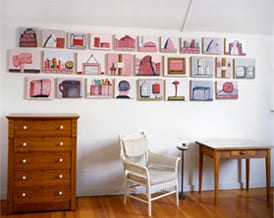
When you paint things they change into something else, something totally unpredictable.
—PHILIP GUSTON
I was a student at the New York Studio School during the fall of 1966 and spring of 1967. The school was then located in a loft building on the northeast corner of Broadway and Bleecker Street. Draft deferments during the Vietnam War were not granted to students attending an art school, especially an unaccredited one like the Studio School. But because I was still enrolled at Reed College in Portland, Oregon, and came to New York on a Rockefeller Foundation Fellowship, I was safe. I studied with Mercedes Matter, Charles Cajori, Esteban Vicente, and especially Milton Resnick, among others. Frank Stella, Gandy Brody, Alfred Leslie, and others gave talks at the school. It was quite an immersion in New York painting culture for an idealistic would-be-painter from San Diego.
After finishing my last year at Reed College in the fall of 1968, I returned to New York. Mercedes Matter gave me a job organizing the library at the Studio School’s new location, the old Whitney Museum building at 8 West Eighth Street. I bought books and organized them into categories. At the time, Maurice Merleau-Ponty’s essay “Cézanne’s Doubt” was a kind of bible to me. I was aware of the difficulties and contradictions involved in the study of painting and put up a sign with a quote from Paul Cézanne: “If you ever founded a school in my name, you have not understood nor even cared about what I have done.”1 Morton Feldman was the dean in those years. In his lectures he often told stories about his friendship with Philip Guston. Even though I was no longer a student there, when Guston came to the school for a special group critique, Mercedes invited me to bring my paintings and later allowed me to join his special seminar.
Like the other students, I saw Guston as a legendary figure with a special history and aura, and was very excited that he was coming to the school. I didn’t see his show, Philip Guston: Recent Paintings and Drawings, in the winter of 1966 at the Jewish Museum, but I studied the catalogue so closely that I began to imagine that I had seen it, only in my memory the show’s location was changed to the Guggenheim Museum. The show was of abstract paintings in black and white with pink and pale blue, but since I only saw the catalogue, in which the reproductions are in black and white, I imagined all the paintings as black and white. The paintings suggested images to me. I saw a painter working at an easel in one of them. In the catalogue the paintings become more and more simplified, until there is only a single painterly black rectangle remaining in the last canvases: a dead end (Air II, 1965, May Sixty-Five, 1965, and Arrival, 1965). In my mind’s eye I still see Air II as the last painting, at the bottom of the ramp at the Guggenheim Museum. Mark Rothko pulled down the shade, Barnett Newman closed the door, Ad Reinhardt turned out the lights, and now Guston seemed to have removed all forms but one. Rumors were circulating that Guston had moved away from New York and had abandoned painting. After that last painting in the show, how could he continue?
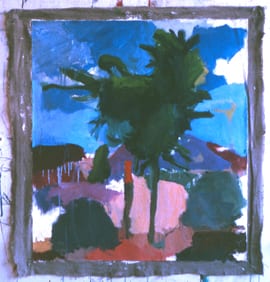
So there was excitement as we placed our paintings around the walls of the large drawing studio on the second floor in expectation of Guston’s arrival. We then crowded in to hear what Guston would say about our works. The paintings I brought to the critique were landscapes painted during the two previous summers in the desert of the Southwest, on the Navajo Reservation. Some were on stretchers leaning against the wall, and others were on loose canvas and just pinned up.
Guston roamed around the center of the room looking at the works, while we moved to the side to give him space. He was silent for a long time, examining what he saw, and then to our consternation, began to speak very critically, very negatively about the work. This was not what we anticipated. We thought that we were standing up for the values he shared and expected praise. But like many art schools, the Studio School had developed a house style, a combination of the influences of our teachers and their idols: Cézanne and Alberto Giacometti, mixed with our teachers’ teacher, Hans Hofmann. To our surprise, Guston was extremely outspoken in his denunciation of these influences and the stylizations that he saw as coming from them. He especially criticized areas of the paintings in which original lines or painted areas were partially erased or smudged and then redrawn. He said that this was cheating; we had to make up our minds about what we were doing. He saw the use of these doubled and erased lines as a way of avoiding decisions. He picked out the work of two painters who were accomplished in this school style and was harsh in his criticism of their work. This was especially upsetting because their paintings were admired and imitated by the other students. Referring, I think, to Minimal painting, he said that their paintings were like “stripe paintings,” something completely anathema to what we thought we supported at the Studio School. He then went on to make his larger point. He said that Piet Mondrian had “eliminated everything but the rhythm to keep his paintings from being tragic.”2 But he asked, “Should painting be tragic?” Clearly he thought it should be. He then said that in modern times art was schizophrenic, meaning that art was removed from life. He saw the influences of the school’s painting tradition as something that was removing us from our own lives and the world in which we lived. Speaking of Mondrian’s grids in relation to the cross structures in Piero della Francesca’s paintings, he said that in Piero’s paintings, “Christ is both dead and resurrected, flesh and spirit. . . . It’s a simple manger and the Son of God.” “In the Renaissance,” he said, “men were together with their lives, both tragic and saved.” Then he went on to say that Piero was not just a Renaissance painter. He spoke about how Piero laid on the paint in quick, rough marks. At the time I didn’t really understand this, since I was thinking of Piero’s oil paintings, but Bill Berkson has clarified for me how Guston was visualizing Piero’s frescoes, in which the marks had to be put down quickly before the plaster dried.
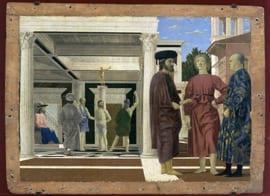
Looking back now, I can see that despite my misgivings at the time about the school style, I had fallen for it. So I am surprised now and was surprised then that Guston picked out my paintings as the exception to the other work. He pointed to my painting of a tree, and said that it reminded him of Piero’s trees. I had brought to the critique several paintings of a tree near a spring and the shack in which I lived in the desert. My paintings were thickly painted, more like Vincent van Gogh or Chaim Soutine than Piero. Often, at the end of the day, I would throw down my dirty brushes and paint directly with my fingers. Guston picked the painting that had more of the white ground showing and which was more thinly painted in some areas. How, I still wonder, with the dissimilarities in surface and style, could Guston have recognized Piero’s influence on my painting? How could he see from my paintings that while I was living in the desert I had been obsessed with Piero’s paintings? He called me forward and told me that he had once talked to a conservator who held Piero’s Flagellation from the Ducal Palace in Urbino in his hands. Tears streamed down Guston’s cheeks as he spoke about the painting. He said that Piero’s paintings have no understandable scale: one can’t tell if the distances between objects in the paintings are miles or inches. He said that there was no way to describe the relation of the group around Christ to the group of figures on the right in the Flagellation. Piero did not belong to any time, but was “a messenger from heaven.”
While I was making those paintings of the tree on the Navajo Reservation in Oljato, I was writing a letter to the San Diego draft board and studying the trees in Piero’s fresco cycle in the Basilica of San Francesco, Arezzo. The frescoes are based on the legend of the True Cross. I had reproductions of the frescoes in several large paperback books from the series I Maestri del colore, and Forma e colore, which I had brought back from earlier travels in Italy, and also Kenneth Clark’s edition of the complete paintings.3 In my letter to the draft board I claimed that this study led to understandings in my paintings that prevented me from going to fight in Vietnam—one of the stranger arguments, I’m sure, ever heard by a draft board in support of an application for conscientious objector status. Piero’s frescos, based on Jacobus de Voragine’s medieval text The Golden Legend, tell the story of the True Cross: a tree and the wood from that tree. Following Adam’s death, God gives his despairing son a branch from the Tree of Knowledge in the Garden of Eden to plant in Adam’s mouth. The wood that grows from this sapling is sometimes recognized and goes through various adventures before it is used to make the cross on which Christ is crucified. Seeing his still corpse, Adam’s children, unfamiliar with death, must have asked: where did he go? Into the tree, is, I think, Piero’s answer. In the fresco, Adam’s daughter screams before a tree, her arms thrown out over the motionless corpse of Adam. This, I thought, was a painter’s interpretation of Christianity. Piero does not paint the crucifixion itself in his fresco cycle. For him it is how spirit survives in matter that is important. For Piero, I believe, the release of Adam’s spirit, immanent in the wood, rather than Jesus’s sacrifice, is the significance of the crucifixion. Perhaps anyone could have released Adam’s spirit in the wood. Piero doesn’t use the standard iconography in which the skull at the base of the cross is Adam’s, and Christ’s blood on the skull is God’s grace. In these paintings, Christ is the second Adam redeeming the first.
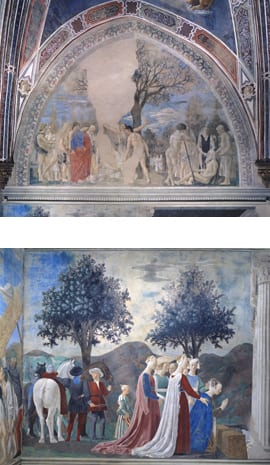
During those summers of painting in the desert, I imagined that the tree that I was painting at the spring in Oljato contained this immanent spirit. At the time, I wasn’t aware how much I was influenced by the content of earlier landscape paintings and photographs in which the American West was depicted as a Garden of Eden. I saw this bright green tree, filled with light in the midst of the dry desert, as the Tree of Knowledge. But living on the reservation and reading about the culture of the Navajos and the Hopi, I didn’t think that this American Garden of Eden was uninhabited. In the Navajo language, Oljato means “moonlight water.” A band of Navajos chased by Kit Carson and American troopers had found this water that saved them when, coming over the mesa at night, they saw the spring near my shack reflected in the moonlight. I loved Franz Kafka’s retelling of the story of the Garden of Eden: we are really still in the Garden, just fooled by God into thinking that we are in exile.
Driven by our love of Italian painting, Guston and I would later one afternoon escape the Studio School to go to the old Academy of Music, a huge ruin of a movie theater on Fourteenth Street, to see one of Sergio Leone’s spaghetti Westerns, For a Few Dollars More. We spoke about the similarities between Piero’s landscapes and landscapes in the movie and the violence in both. I had first seen these movies in Venice and had always connected them with Italian painting. In Piero’s fresco The Slaying of the Son of Chosroes, in Arezzo, the son of Chosroes falls back, stabbed in his throat, the red strap of his helmet severing his neck. The emblem of a flower blooms on his helmet, and his mouth is under a cross, which seems to absorb his spirit. Above him, on the other side of an empty throne, a crowing cock stands on a column. The silence of the transformative violence in Piero’s fresco reminded me of Leone’s shootouts. Guston must have also liked Leone’s close-ups of faces and objects. That day, a large hole—a walk-through opening—had been cut into the right side of the screen at the Academy of Music. We also visited the Frick Collection to see Piero’s paintings there. A guard asked us to leave, accusing Guston of “lecturing” in front of Goya’s The Forge. Guston thought that this painting and Rembrandt’s The Polish Rider were the most realistic paintings in the Frick, the most human—at least on that day.
• • •
When he spoke to us about our work, why did Guston insist that painting be tragic? Looking back, it is easy to see that his comments were in relation to the transition going on in his own work. At the time, none of us knew anything of his new drawings and paintings that depicted simple objects. In the school’s upstairs studio, where he worked as a resident artist, I later was able to glimpse some of the drawings. I was amazed by this transformation in his work. But I don’t think that this shift to depicted objects was the only cause for what he said. Piero wasn’t tragic because his work was figurative, and Mondrian wasn’t tragic because his paintings were abstract. Guston’s work always had aspects of both figuration and abstraction, shifting back and forth between the two. Once I told him that I thought an “abstract” painting of his I had seen in Buffalo at the Albright-Knox Art Gallery (perhaps it was Untitled 1958, #47 in Fort Worth retrospective) was based on Jean-Antoine Watteau’s L’Embarquement pour l’île de Cythère.4 Guston said that I had found him out. The way he depicted objects in his work was a surprise. There was a cartoon aspect to his imagery that at the time seemed related to the use of cartoons in Pop art. This made many of the artists of his generation angry (with the exception of Willem de Kooning, who told Guston that he liked the new paintings). To other painters, it seemed that Guston was defecting to the enemy, a younger generation of artists who had driven out and replaced the second-generation New York school painters who had expected to inherit the mantle of the Abstract Expressionists. I don’t think Mercedes approved of Guston’s new work, and Feldman, at the time, was quite outspoken about Guston’s betrayal.
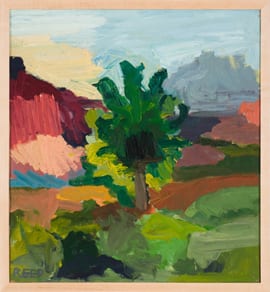
Combining Pop and abstraction is currently so accepted in the New York art world, that it is hard to imagine how controversial the change in Guston’s work was at the time. The Pop aspect of his new work, like the figuration, didn’t bother me. But this is the place, I think, to confess how much I was troubled by his new paintings. I was most unnerved by their changed surfaces. It was the crudeness of the paintings that bothered me. His earlier paintings were so elegant and poetic. Now I realize that this new surface was a byproduct of the change that Guston was going through—evidence of the tragic. He was painting directly from and in relation to his life, without any stylizations, and without artiness. My colleague Fabian Marcaccio calls these later works of Guston’s realist, and the surface is realistic and matter-of-fact, in a way that is beyond being figurative or cartoonlike. Fabian describes them as being painted with grease instead of paint. Guston shows how the world is, revealing himself fully: his smoking and eating, fears and obsessions. Another colleague, Klaus Merkel, calls the surfaces of these paintings cruel, and they certainly are. And Guston himself is cruel in the paintings. Through the surface he implicates himself as a sinner, not just accuses others of sin.
If it wasn’t just a shift to figuration, what did Guston mean by the tragic? My other favorite teacher at the Studio School in those years was Resnick. He told me about a phrase used by his painter colleagues that can perhaps explain further what Guston meant. It was a phrase that Resnick used to describe the method and difficulties of an artist changing his or her work: “soul-beating.” He said that some artists could “beat their own souls,” but some could not, and needed someone else to do the beating for them, a friend or an enemy. If I understand correctly, I think that by soul Milton meant all the traditions and beliefs from the past that affect our thinking. For Resnick, spirit was the opposite of and had nothing to do with soul. As an artist, one had to learn to be critical of one’s beliefs and the traditions that one cared so much about, had to learn to push on from those beliefs into something else.
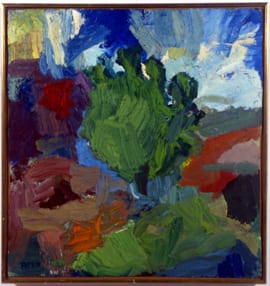
Guston, at the time he spoke with us, was trying to do this for himself, to change himself. He was exceptionally open both in his critique and later in the seminar. Unsure of himself and what he was doing, he was never acting a part, though his resemblance to a character from a Fellini film told me that putting on a show would have been easy for him. In the Studio School style, Guston saw the traditions that he was trying to beat from his soul. I think that this is why Piero’s Flagellation came to his mind and why it was so moving for him to speak about that painting. It was an image of his own current soul-beating. Thinking about this now, I see his Ku Klux Klan hoods with their whips in a new way. These are soul-beater artists at work: the tragic in operation. Guston implicates himself in the evildoings of the KKK hoods. Berkson reminded us that “the image is adapted as well from seeing Piero’s members of the confraternity the Miseri-cordia, who wore their hoods—black where the Klan’s are white—to keep their identities secret, but out of charity and self-effacement rather than hatred and fear.”5 Many other images in Guston’s paintings could be related to soul-beating: the nails, the clubs, and the bricks and stones, which are like the stone St. Jerome used to beat himself in the desert. I especially like the paintings in which all the objects are swept away by floods of blood. But I should be clear: I mean that these are objects of soul-beating in an artistic sense only, without the usual iconographic, religious meanings—they are images of how a painter can use painting to change him- or herself. The books in Guston’s paintings are also tools for this soul-beating. In the critique he recommended that we read Roberto Longhi on Piero, Osvald Siren on Chinese aesthetics and philosophy, Charles Baudelaire’s writing, and Eugène Delacroix’s journals.
I saw more of these later paintings of Guston’s at the openings and shows in the 1970s at David McKee Gallery in the Barbizon Hotel for Women on East Sixty-third Street. Guston came to these openings, which were attended almost exclusively by young artists. It was the young artists who understood in those years what he was doing. I often see prints or drawings by Guston in the studios of artist colleagues. For example, I recently saw a beautiful print in David Row’s studio. During the 1970s, another painter colleague, Jake Berthot, told a story that he had heard from the artist. Guston had run into de Kooning by chance in a supermarket in Long Island, both of them pushing their carts. De Kooning in his high-pitched voice asked, “Well, how does it feel, Phil? How does it feel?” Guston said that he didn’t understand: “How does what feel, Bill?” “Well, how does it feel?” de Kooning said, “They used to copy me and now they copy you.” And then he added, “Isn’t it strange. It’s the part that you are least sure of, that’s the part they copy.” De Kooning understood transformation through painting well. In his 1950 painting Excavation, he signed his name as the teeth of a skull in the bottom right of the painting—Adam’s skull. In the center of the painting, a door is ajar, as if he had walked through it and discarded his old self. During Guston’s critique, in some way, not very consciously, I must have gotten the message about this transformation through painting. There’s a final sentence in my notebook entry: “. . . have to do it in NY, so not just done in Southwest.”
• • •
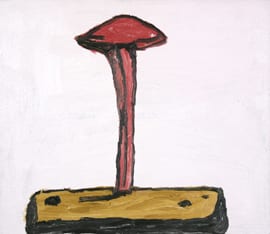
Another aspect of Guston’s paintings from around 1968 and 1969 especially interests me now: his use of a white ground behind the objects in his paintings. I suspect that he was inspired to use these grounds after seeing the paintings of James Ensor, who was perhaps the first to use them. In his early portraits, Ensor often has a source of light, a window or a light-colored wall, behind a figure (e.g., The Somber Lady, 1881, and The Lamp-Lighter, 1880). What is strange about the light in Ensor’s paintings is that there seems to be no source for the light from outside the painting; instead, the light seems to be a screen with a certain thickness inside the painting. The light is strangely artificial. Later this white light changes from the visionary light of his early religious paintings into the harsh, satiric light of the white grounds in his late works. In those works. it is as if we see the world in the harsh spotlight of an interrogation. Guston’s white light works in a similar way.
Guston’s white grounds isolate the objects, obfuscating their context. This isolation emphasizes the particular qualities of the depicted objects—their distinct shapes, colors, and dimensions. In the alphabet paintings, there is sometimes just one object, and this separates the object from others even further. Each object is reduced to a potential linguistic element. Because of its resemblance to the white paper backgrounds of cartoons, the white ground makes that relation stronger. But the white ground also does something else. As Berkson writes, the white puts the objects into “the in-between-ness that Guston painted—where the ‘thing’ is visibly turning into or shows the capability of being other [the piece of bread into shoe into moon . . . as Guston said], something else.”6 The white ground creates a screen of light, a theatrical and filmic light, in which objects are uncanny and seem capable of transformation. It makes the ordinary seem strange. Why is there such a focus on that ordinary thing—that coffee cup, painting, easel, or chair? One has the feeling that it is because something strange is happening within that object. The white ground can also be seen as some kind of reflected light that obscures the world around the object. This can sometimes make the objects seem as if they were reflections in a mirror, not belonging where they are.

When this sense of strangeness and potential transformation is repeated in many different objects, and in many paintings, it seems to be a way of seeing the world and implicates the painter in the change. In the quotation in my epigraph, Guston speaks about objects changing into something else when he paints them. I keep misreading the quotation to say: “When you paint things they change you into something else, something totally unpredictable.” It’s not just the objects themselves that change; the painter himself or herself can also change through this process. A 1960 painting by Guston, Mirror—to S. K., acts out this process, depicting what this kind of transformation might be like. One can see the figure of the painter in the right foreground looking at himself, his shape, reflected in a mirror. There are wonderful pale pink strokes of paint over a surrounding black area connecting the painter and his reflected image. The shapes of the painter and his reflection seem both pulled together and different with that light between them.
When we look at ourselves in the mirror, it is a way to test our identity and decide if we have changed. Guston must be thinking of this experience in this painting and wondering how painting might be changing him. Now we also look at films, video, computers, and other screens of light, along with mirrors, to test our identity. We can identify with the figures on the screen and through them recognize parts of ourselves that we desire or parts that we might not want to acknowledge. I keep thinking of Bela Lugosi as Dracula in Tod Browning’s film, knocking down the silver mirrored cigarette case (which looks like a computer) when it exposes him as a vampire. I feel that while watching movies we also change into a creature like Dracula; parts of us are still in our lives, and parts, through our identifications, are something else. Like the vampire, we are part alive and part dead. Through seeing ourselves reflected in the media, we are changing. There are great pleasures and some terrors in experiencing these screen presences. We are still human—this process can feel very human—but sometimes I fear that we are changing from human to something else. Painting can explore these changes in this age of media. The vampire’s kiss of the media of mechanical reproduction, which was thought to be the death of painting, rather than killing painting, has made it immortal. With its history and conceptual possibilities, and in combination with media, painting can explore how we are being changed. What parts of being human should be preserved? How are we being changed?
In his 1965 text, “Piero della Francesca: The Impossibility of Painting,” Guston writes of the Flagellation: “Possibly it is not a ‘picture’ we see, but the presence of a necessary and generous law.”7 That is quite a phrase: necessary and generous law. The law in Kafka is certainly not generous. What does Guston mean? This necessary and generous law might be the transformation of objects and of ourselves that he discovered through painting and in Piero’s work. Guston goes on to say that we have to doubt the final outcome of these transformations. We do. Perhaps this is the tragic.
Born in San Diego in 1946, David Reed studied at the Studio School and in 1971 moved permanently to lower Manhattan, where he continues to live and work. His recent exhibitions have been at Galerie Schmidt Maczollek in Cologne and Peter Blum Soho in New York (works on paper). In March 2010 he will have an exhibition of paintings (along with photographs by William Eggleston) at Peder Lund in Oslo. Recent publications of his work include Tony Godfrey’s Painting Today (Phaidon, 2009) and his own Rock Paper Scissors (Kienbaum Artists’ Books, 2009).
The epigraph is from “Philip Guston Talking,” in Philip Guston: With a Lecture Given by Philip Guston at the University of Minnesota in March 1978, ed. Renée McKee (London: Timothy Taylor Gallery, 2004), 32.
- I have found references by several authors agreeing with the meaning of this statement and have found other statements by Cézanne which are close in meaning, but, after all these years, I have been unable to locate my direct source. Probably it comes from the collections of quotations attributed to Cézanne by Emile Bernard, Joachim Gasquet, or Leo Larguier. ↩
- I transcribed the quotations in this paragraph in my notes on the seminar, and I also transferred them to a notebook. I still have notes and notebook. ↩
- Kenneth Clark, Piero della Francesca: Complete Edition (London and New York: Phaidon, 1951). ↩
- Michael Auping, exhibition checklist in Philip Guston: Retrospective, exh. cat. (London: Modern Art Museum of Fort Worth and Thames and Hudson, 2003). Auping organized the exhibition for the Fort Worth museum. Number 47 on the checklist, reproduced in the book, is Untitled, 1958, oil on canvas, 64 x 75⅛ inches, Private collection. ↩
- Bill Berkson, “Guston, Piero, and Their Followers,” talk presented at American Academy Rome, Villa Aurelia, Rome, May 25, 2010, rep. Philip Guston: The Late Work (Rome: American Academy in Rome and Museo Carlo Bilotti,
2011) 4-5. ↩ - Berkson e-mail to the author, June 15, 2010. ↩
- Philip Guston, “Piero della Francesca: The Impossibility of Painting,” Art News 64, no. 3 (May 1965): 39. ↩

